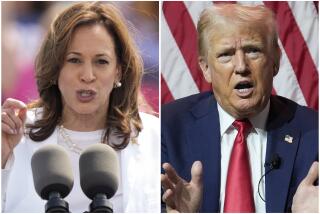Clinton Rides High on the Economy
- Share via
In the battle over the country’s economic future, Bill Clinton is clearly the fiscal conservative while Bob Dole is the supply-side radical in the Reagan mold. Clinton seeks fiscal restraint as unemployment drops, while Dole wants to pump $700 billion in tax cuts into an economy that last quarter grew at a resounding 4.8%. Is it surprising that the public is skeptical of Dole’s program?
Clinton’s reluctant remaking as an “Eisenhower Republican” concerned about the bond market has worked. The deficit is less than 2% of gross domestic product and runs below the rate of economic growth, so the burden of outstanding debt is finally declining. Interest rates are steady and inflation is low. Rising wages at a time of price stability and high corporate profits imply, as N.Y. financier Felix G. Rohatyn recently noted in the Wall Street Journal, that productivity is increasing and workers are getting deserved benefits.
It is a stunning shift to hear Bob Dole directly extol the virtues of Reaganomics when he had been so scornful of supply-side theories in the past. Kemp-Roth in 1981 was also a 15% across-the-board income tax cut that meant, after Congress added its additional loopholes, that the budget was destined to be busted, notwithstanding Dole’s tireless efforts to patch it up with tax increases. The only saving grace of that deficit-inducing cut was that it came, like Kennedy’s tax cut, at a time of stagnation when the economy needed a stimulus. Reagan’s growth package has long been called military Keynesianism: Stimulate the economy by cutting taxes and spending more on defense, thereby running massive deficits.
Now, after 3 1/2 years of slow but steady growth, a half year of rapid growth and a 5.1% unemployment rate (lower than conservative economists believe it can safely go), it’s hard to come up with an economic theory to justify the explosive increase in private demand that Dole recommends. Even the most liberal form of Keynesian economics prescribes balanced budgets and budget surpluses when the economy is at full employment. Reaganomics failed in part because the deficit continued to be huge after many years of rapid economic expansion.
But Clinton’s fiscal course is much tighter: If the economy continues to grow toward 4% unemployment, the deficit will virtually disappear as a percentage of GDP; and it will disappear entirely with growth and the additional spending cuts assumed in the seven-year budget balancing plan.
Because so much of Dole’s tax cut goes to the well-off, the only justification for his program is an extreme version of trickle-down economics. A full three-quarters of the benefits of the Dole tax cuts go to the top 20% of taxpayers, precisely those who have done so well in the past 15 years. The very rich--the top 1%--get as large a share of the tax cut--27%--as the bottom 80%. The top 1% receive an average of $29,000 per taxpayer, while the ordinary taxpayer receives an average of about $330. While families with children will receive more, most of those benefits come from the $500 per child tax credit, which Clinton has also supported.
So the ostensible benefits of the Dole program hinge on the argument that the rich will invest their capital gains and income tax breaks in productivity-expanding investment so the economy can grow even faster.
According to Citizens for Tax Justice, the Dole package will more than double the deficit, currently at $120 billion. Such a stimulus at a time of low and declining unemployment can only mean an inflationary threat and higher interest rates, which squelch investment, not faster growth. (While Dole’s tax cut package is designed to be phased in, the markets will anticipate growing deficits). Alternately, if the unspecified cuts that Dole has promised in order to pay for the tax cut are enacted, they are bound to disproportionately impact (e.g. through additional Medicare cuts) the 80% of the population that receives the short end of the proposed tax cut. As with Reaganomics, the distribution of taxes and potential cuts in his plan will only exacerbate the country’s growing inequality. Either way, the policy does not compute for the majority of Americans.
When Clinton ran in 1992, “it’s the economy, stupid” became the informal catch phrase of the campaign. Fiscal conservatism, undertaken in spite of his personally more expansive views, has paid off: The Clinton expansion is conveniently peaking at election time. In contrast, Dole’s proposed radical shift in economic direction becomes increasingly unconvincing to an electorate that can only appreciate that Clinton has delivered on the central promise of his presidency.
More to Read
Get the L.A. Times Politics newsletter
Deeply reported insights into legislation, politics and policy from Sacramento, Washington and beyond. In your inbox three times per week.
You may occasionally receive promotional content from the Los Angeles Times.










